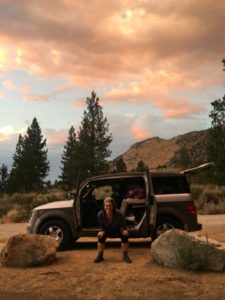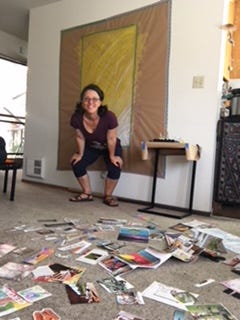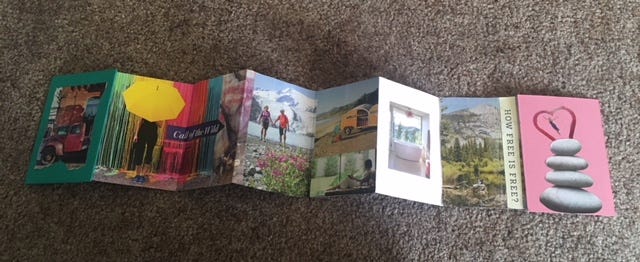This article first appeared on Medium.com and you can read it here.
I’m back from my month-long vacation in the great outdoors, and wow!! Transitioning back to work as an educator and academic coach has been a buggaboo.


I’m back from my month-long vacation in the great outdoors, and wow!! Transitioning back to work as an educator and academic coach has been a buggaboo.
Do you struggle with transition this time of year? It’s a big hard deal, and we are all in it?—?students, parents, educators.
Few people talk about the start reality of it. So let’s go.
Get ready for some honest truth about how my transition was, and how I dealt with it using the very same tools I teach students during the school year.
First things first, we (or at least I) go into summer vacation with such high hopes for rest, relaxation, adventure, and decompression time. I rented two different camper vans and took off to the Yuba River for 7 days (see me sitting in the water up there? heaven!) and the Eastern Sierras for 10 days (check out the converted Honda Element and the gorgeous sunset). Gazing at mountains, sitting in rivers, and hiking along mountain creeks was the plan, and also the reality! Parts of this trip were truly magical.
Inevitably, though, vacations often don’t go quite as we (I) had hoped.
In my case, I got a horrible migraine while I was camping alone outside of cellular range. It was horribly painful and took several days to recover from completely. Being in that much pain alone in the wilderness brought out a deep loneliness that I didn’t want or expect.
Fast forward to a week ago Thursday. I was having dinner with a friend. She’s the mother of a former client (he just graduated from high school! woohoo!!), a middle school administrator, and through the years that I’ve been coaching her son, has become a good friend.
She asked me how my summer vacation went, and I immediately launched into:
“I hate transition! I had a good time on my trip but it wasn’t nearly as good as I fantasized it’d be, and now I can’t bring myself to go back to work. I feel horrible. I hate this time of year!”
(Ok. I don’t know if I was that dramatic, but that’s how I felt on the inside).
She nodded vigorously, smiled, and said, “You basically describe me!”
I don’t think we educators talk ENOUGH about how hard transition is.
Not many other professions go cold turkey on work for a couple months, and then have to start up full steam in the fall.
Frankly, it sucks. Though I love the opportunity to savor a long vacation, I hate how hard it is to start working again.
For years now, I’ve been telling friends and clients a pet theory of mine, based on thousands of hours coaching teenagers and talking to their parents: the root of all human difficulty takes place during transition.
That sounds like an overblown statement, right? For the time being, though, let’s assume that this statement is true.
Specifically, since I’m an academic life coach for students, let’s think about the impact of transition on students.
Consider this: how many transitions do students go through in the course of a standard school day?! I count a minimum of 7 for the average middle or high school student: (1) Wake up, (2) Get out the door , (3–9) Arrive at school and then transition through 7 classes, (10) Go home, (11)?—?Start homework , and (12) Go to bed.
That’s a BUTT LOAD OF TRANSITION… and most students have even MORE transitions than these (count ’em up! you’ll see). As a double whammy, most of these transitions are controlled by external forces and are not internally chosen or driven.
I don’t know about you, but in my average work day as a grown up, I have many fewer transitions than that. And my brain is fully formed! Imagine if you have a growing teenage brain that is basically designed to struggle with executive functions like task initiation, planning and organizing, self monitoring, impulse inhibition and more!
For the reasons outlined above, I consider that my main job as an academic coach is to help students navigate transitions. I want to give them the TOOLS to navigate these transitions as effectively as possible, as well as help them PRACTICE USING THESE TOOLS in their own lived reality.
The 5 categories of tools that academic coaches help students collect are pare:
- Organization?—?tools and strategies for organizing things and ideas so that you can find them easily when you need them
- Time Management & Planning?—?tools and strategies for organizing time and following through
- Strategic Study ing— tools and strategies for effective and efficient learning, so that students are prepared for every test
- Self Advocacy?—?tools and strategies for noticing what you need and speaking up about those needs with peers and adults
- Self Talk?—?tools and strategies for countering the negative thoughts that often keep us from feeling good about ourselves and following through
Through my 10+ years in this work, I have countless stories of how students are calmer and more confident after they collect a chock full toolbox of strategies in these five categories, and then practice applying these tools so that they can do so fluently, without much conscious thought.
It simply feels GOOD TO KNOW that when hard things happen in life, one of the tools in your toolbox will likely help you.
However…
As the airlines constantly remind us, it’s important to put on our own oxygen masks first. How can we expect STUDENTS to practice using transition tools if we?—?the adults who parent and teach them?—?don’t have enough tools in our own toolboxes!?
I’ve seen with my own two eyes that parents and teachers often expect students to be able to create and sustain habits (for organization, time management, studying, self advocacy and self talk) that the adults around them aren’t able to create themselves!
That doesn’t seem fair, does it? I don’t think so.
So this school year?—?as I gear up for a new round of my flagship course for educators?—?I’m also starting to do a ton of writing. I’ll be reflecting regularly about all the ways that I integrate the these five sets of tools into my own life, to make sure I’m being in integrity with the students I teach.
How do I put “the oxygen mask” on myself first in regards to using all the tools I teach students? How does this practice help me be a better coach and teacher? How might other adults follow this practice too?
To provide an example of what I mean, I’d like to take the rest of this article to reflect about MY transition back to work this school year.
Because it’s important for me to practice what I preach, I’d like to demonstrate how?—?when I was stressed beyond belief on my first day back to work?—?I was able to access my own personalized transition toolkit to ease myself back to work with some grace and joy (amidst the whining; yes, there was still whining). I’m so grateful for my toolbox!
When I got back from the camper van vacations described above, I actually had the foresight to plan an entire week’s buffer between vacation and work.
Even with that buffer, however, when Monday August 6th rolled around, I couldn’t bear to open my computer that morning. I felt anxiety in the pit of my stomach and I wanted to, well, run screaming.
Dare I be this honest? I actually do love the work I do, so I KNEW that if I just got started, and took one little step at a time, I’d be ok. However, my poor nervous system didn’t know that. Whenever I looked at my computer, or even thought about my email, I felt a pang deep in my belly that seemed to say, “Run! You’re in mortal danger! You’re being chased by a tiger!!”
Luckily, I know myself. I’m aware I need to ease in.
I’ve been working very hard over the last decade to put together my toolbox to help in just these moments. When the anxiety set in, I momentarily forgot that I even had a toolbox. But as soon as I remembered, I took a moment to remember what my favorite transition tools are:
Gretchen’s Unique Personal Toolbox for Navigating Transition
- Incrementality. Take action! Any action! No matter how small!
- Self Advocacy. Reach out, let others know the state of my nervous system, and ask them to check in on me.
- Creativity. Make something creative. Bonus points if it’s pretty or involves paint or collage. Make sure that whatever I decide to make is somehow connected to the thing I am procrastinating or feeling axious about.
- Meander. Ease off the “driver” mentality. Let myself meander and follow my desires and impulses, but do it in a time bound way so that I have a clear end.
- Exercise. Get exercise and move my body.
What a great list! As soon as I remembered it, I felt calmer. Here’s what I did next:
First, I texted about 10 people in my support network (these are folks with whom I have a spiritual and emotional connection and who I trust to receive my raw truth with care and love). Here’s what I said (edited slightly so that I feel comfortable sharing my words with the internet):
“I’m noticing I’m wanting my community to witness the fact that I’m going back to work today. It feels really scary. There are parts of me that don’t want the responsibility of caring for all my clients and having to make money to support myself. […] If you have time and space to check in with me later today and see how the day has gone, I would love that! If not, I totally understand.”
After sending the text, I noticed the impulse to make some art. So, I set up a new empty paper on my art studio wall. I asked myself what color I wanted my business to feel like this semester, and yellow came to mind. I let myself paint in broad, brush strokes, and even used up my whole jar of yellow. It felt so satisfying.

As I was painting, I remembered that my business coach had sent me a kit for making her “Right Brain Business Plan” process. I realized: Oh! Wouldn’t it make sense for me to get more clear on my vision for my business this semester BEFORE I dive into responding to client requests? And what if I did that by making a vision board?
The rest of the afternoon I spent collaging. As you can see fro the picture above, I made quite a mess! But I’m so pleased and proud of the collage filled with images of how I want my work to FEEL this school year:

Occasionally my cell phone pinged with a friend responding to my morning text, checking in on how I was doing. Each time someone reached out, I felt a warm glow in my chest that hadn’t been present early in the day, when I was so anxious.
I took a couple breaks: one to go to a yoga class, and another to take a walk around the nearby Lake Merritt, which I was willing to do because I remembered how important exercise and being outdoors is to my motivation.
Although I never did check my email that day, I DID reach out to my assistant to find out whether there was anything pressing. And I made a plan to check email right after my “welcome back” meeting with my assistant the next day.
And most importantly, I felt completely inspired to come back to work in a way that would make the feelings in my collage a reality. Here is my final product of what I’d like my work to feel like over the next year:
I LOVE that I had such a robust toolbox of self care tools to help me manage my anxiety during this confronting transition from summer to school year.
I think it’s particularly cool that my toolbox is very similar to the tools I teach my student and adult clients! Check out how my own actions this past week correspond with the five toolkits students need to navigate their own transition:
- Organization: I have an overflowing toolbox of self care strategies that I have memorized and easy access to. I surround myself (at my home office) with all the tools I need to put these strategies into action at any time (paints, a blank studio wall, magazines for collage, glue, scissors, my support network bookmarked in my phone, etc)
- Planning and Time Management: I had built in a time buffer (i had planned my transition back so I didn’t have to be “balls to the wall” so to speak, and I had time for creativity AND the practical.
- Strategic Studying: Although I technically wasn’t “studying” per say, I was employing a central tenet of my Anti-Boring Approach to Powerful Studying (which is my wacky articulation of a brain-based approach to teaching students how to study). I didn’t paint just for fun, as a way to procrastinate. Instead, I knew how to connect the creative act of painting and collage to the CONTENT at hand?—?I used the painting and collage as a vehicle for getting clear on the vision for my business.
- Self Advocacy: I have a community of support and a lot of practice accessing them. I no longer feel ashamed to reach out, and I’m good at knowing how to ask for what I need.
- Self Talk: There were a few moments when I had a mean thought sneak into my head. “You’re so lazy! Look at you, painting and collaging instead of getting to work. You’ll never build a successful business this way! What privileged baloney you preach!” Ugh. That’s super mean, isn’t it? Luckily, I have a bunch of tools (that I don’t have time to talk about here) to help turn the volume down on all my mean voices, and I used those tools during the day.
So what’s the point? Why am I writing about this here? what does this have to do with students and learning? Or being a teacher or an academic coach?
I guess for one thing, I simply want to affirm that TRANSITION IS HARD! For all of us. Especially this time of year. Please don’t beat up on yourselves if you are feeling that.
I also want to ask the parents and educators out there?—?what tools are in YOUR personal transition toolbox? Do you have easy access to those tools? The school year is a stressful time, so we need our toolboxes replenished, out and visible. Have you put your own oxygen mask on first and organized your own School Year Sanity Toolbox? I hope so.
And if you haven’t, that’s ok too. But please mark some time on your calendar to do that. And if you have no idea where to start, please reach out to me via my website! Perhaps I can help get you started.
